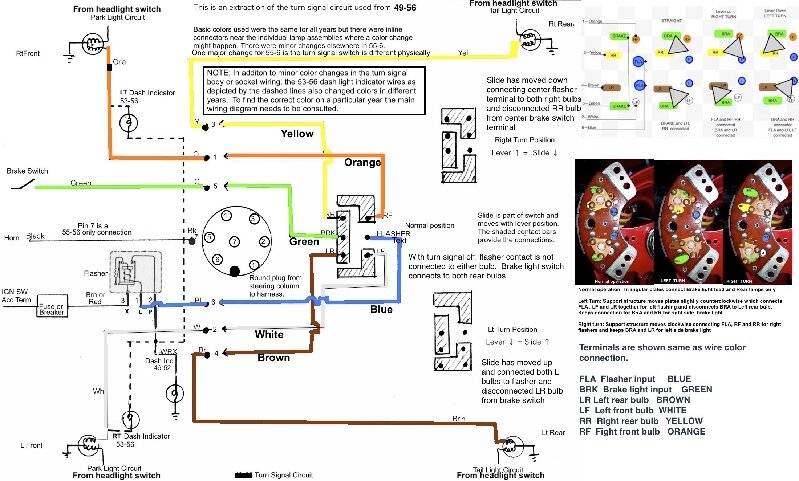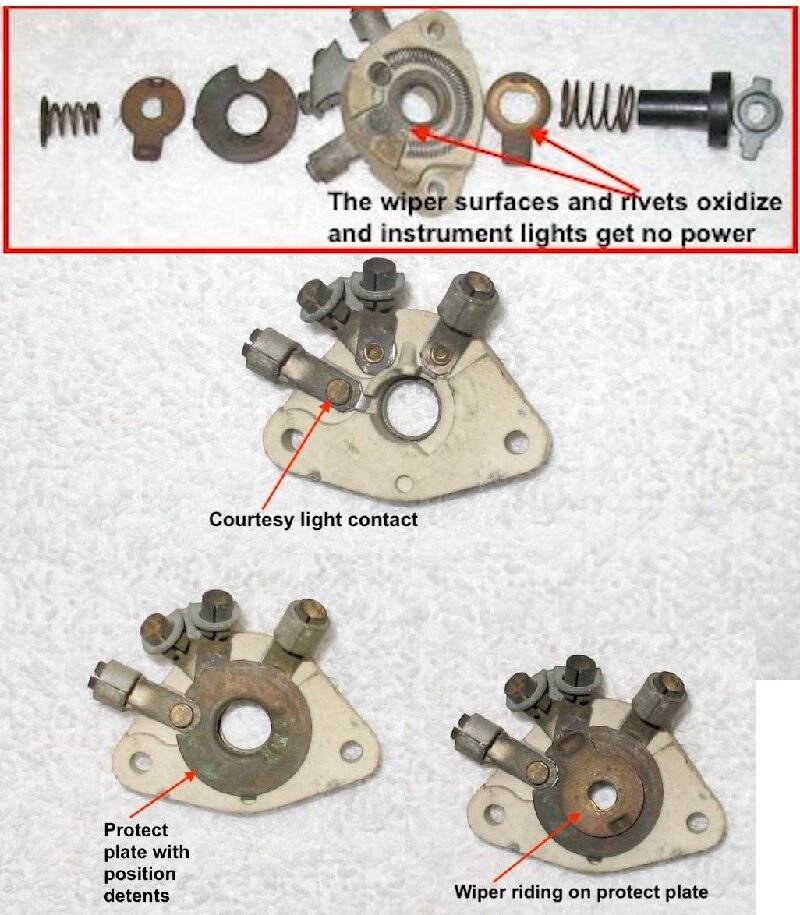Re: Subject:* Dash Fuses
Posted by HH56 On 2023/3/13 13:36:10
Those particular lights are on different circuits and on 51-4 models typically do not use fuses. There may be some fuses used on accessories such as the radio, heater, or overdrive and a few other things but not on the more or less basic items.
Brake lights are protected by the body feed circuit breaker located on back of the instrument cluster. The output from the switch then enters the turn signal switch where the line is split and goes to the rear bulbs. Failed brake light switches (which on a 51 is in the brass block at the end of the master cylinder) are a well known issue so rule that out first.
Turn signals are protected by the aux breaker also on back of cluster. The flasher signal also goes thru the turn signal switch. That switch is known to get dirty contacts or a fiber contact support plate in the switch warps. Either can result in a loss of connection and no lights.
The dash lights are fed from the headlight switch tail light terminal and the switch has its own circuit breaker. They are controlled by a rheostat on the headlight switch which is another known issue because the wiper plate oxidizes and voltage cannot reach or pass thru the rheostat and power the bulbs. The rivet connection between terminals and the contact plates are another known place to check. If someone removed a wire and the terminal is twisted or pulled excessively the rivet can loosen and a poor connection results.
Reverse lights were optional and could have been installed by a dealer. If dealer installed and factory instructions were followed they are protected by the aux breaker. Sometimes dealers did their own thing so they could be one of the few lights that might have a fuse or be powered from somewhere other than where the factory intended.
Corroded grounds are a notorious issue with any Packard having pot metal parking light and tail light housings. Parking light ground goes thru several pieces of the grille before reaching sheet metal and any of those places where pot metal touches and needs to pass current can be at fault. Grille and Tail light pieces often corrode or rust where the stud that holds the grille or housing needs to make a good contact with the body metal. Rust can be an issue. Sometimes just removing nuts and using a wire brush on the sheetmetal works but in the case of parking lights some have had to resort to adding a ground wire directly to the parking light socket and running it back to sheetmetal.
Turn signals are particularly dependent on having good grounds in the circuit. The original flashers are designed around the filaments and connections being in a specific resistance range so any poor grounds and the balance can be thrown off enough the old thermal style flashers will not work. Modern electronic flashers do not have that issue and some have converted to that type. If you do make a conversion and the car is otherwise stock be sure to get the flasher that works with positive ground. IIRC, someone posted a brand and number for a 6v electronic flasher not long ago.
Here is a breakdown of the turn signal and brake light circuits as well as a headlight switch showing where the typical issue of dirty wiper contact plate is found.
Attach file:
 49-56 Turn Signal Extraction2.jpg (240.08 KB)
49-56 Turn Signal Extraction2.jpg (240.08 KB)

 headlight sw courtesy light section.jpg (139.35 KB)
headlight sw courtesy light section.jpg (139.35 KB)

 headlight sw 51-6.jpg (63.44 KB)
headlight sw 51-6.jpg (63.44 KB)

Brake lights are protected by the body feed circuit breaker located on back of the instrument cluster. The output from the switch then enters the turn signal switch where the line is split and goes to the rear bulbs. Failed brake light switches (which on a 51 is in the brass block at the end of the master cylinder) are a well known issue so rule that out first.
Turn signals are protected by the aux breaker also on back of cluster. The flasher signal also goes thru the turn signal switch. That switch is known to get dirty contacts or a fiber contact support plate in the switch warps. Either can result in a loss of connection and no lights.
The dash lights are fed from the headlight switch tail light terminal and the switch has its own circuit breaker. They are controlled by a rheostat on the headlight switch which is another known issue because the wiper plate oxidizes and voltage cannot reach or pass thru the rheostat and power the bulbs. The rivet connection between terminals and the contact plates are another known place to check. If someone removed a wire and the terminal is twisted or pulled excessively the rivet can loosen and a poor connection results.
Reverse lights were optional and could have been installed by a dealer. If dealer installed and factory instructions were followed they are protected by the aux breaker. Sometimes dealers did their own thing so they could be one of the few lights that might have a fuse or be powered from somewhere other than where the factory intended.
Corroded grounds are a notorious issue with any Packard having pot metal parking light and tail light housings. Parking light ground goes thru several pieces of the grille before reaching sheet metal and any of those places where pot metal touches and needs to pass current can be at fault. Grille and Tail light pieces often corrode or rust where the stud that holds the grille or housing needs to make a good contact with the body metal. Rust can be an issue. Sometimes just removing nuts and using a wire brush on the sheetmetal works but in the case of parking lights some have had to resort to adding a ground wire directly to the parking light socket and running it back to sheetmetal.
Turn signals are particularly dependent on having good grounds in the circuit. The original flashers are designed around the filaments and connections being in a specific resistance range so any poor grounds and the balance can be thrown off enough the old thermal style flashers will not work. Modern electronic flashers do not have that issue and some have converted to that type. If you do make a conversion and the car is otherwise stock be sure to get the flasher that works with positive ground. IIRC, someone posted a brand and number for a 6v electronic flasher not long ago.
Here is a breakdown of the turn signal and brake light circuits as well as a headlight switch showing where the typical issue of dirty wiper contact plate is found.
Attach file:
 49-56 Turn Signal Extraction2.jpg (240.08 KB)
49-56 Turn Signal Extraction2.jpg (240.08 KB)
 headlight sw courtesy light section.jpg (139.35 KB)
headlight sw courtesy light section.jpg (139.35 KB)
 headlight sw 51-6.jpg (63.44 KB)
headlight sw 51-6.jpg (63.44 KB)
This Post was from: https://packardinfo.com/xoops/html/modules/newbb/viewtopic.php?post_id=254898